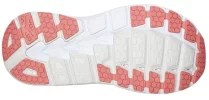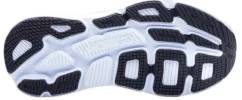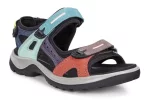It is not the depth of tread that determines traction on smooth surfaces, but the material compounds used in the outersole. The less flexible and stiff the outersole, the more slippery on smoother surfaces.
You mentioned Hokka One One. In general, there are some models, like the Bondi series (I use the version 6. Version 7 will be along shortly) which are very good with wet and smoother surface traction.
When I gear tested the Bondi for Hoka I was very concerned about wet surface and smooth surface traction. As the testing continued, I was pretty amazed at how well they gripped. Even on wet and smooth tracks. When I looked closely at the outersole with a magnifying glass, I readily saw why: there a thousands of micro-sipes on the sole. A sipe is simply a thin slice in the material. The slices remain closed until pressure is applied, then they will slightly open up which exposes hundreds of teeny edges. It is these edges which create the grip.
Softer compounds (relative. . they are not really anywhere near being squishy or spongy) also allow for micro-pitting to occur, which also adds to the traction.
Hokka is not the only shoe manufacturer that employs this technology.
Deeper treads, like shallow lugs, can help with regard to hard smooth surfaces which have a thin layer of slippery debris laying on top. That debris, like sand, sits on top of the hardpan or concrete or asphalt, etc and will act like micro ball bearings. You plant your shoe or boot, and the debris will start slipping over the underlying hard surface. You suddenly slip and 'boom. . . you are on the ground.
This is most dangerous going downhill. . . don't ask me how I know

Shallow lugs put focused pressure that tends to do a better job of penetrating through that debris so that it shoves it out of the way. That reduces the amount of slipping.
For shoes like the Hokka Bondi, the micro sipping can help in such a situation, but not as much as with a shallow lug. Conversely, a shallow lug can make smooth or wetted hard surfaces more slippery.
For all shoes, the 'heel plant' is the best method for dealing with down slopes with loose debris over a hard surface. As you step down, make sure you plant the outer edge of your heel first. This will help to force the shoe through the debris layer and better secure your footing as you continue your step forward.
Whatever you do, do NOT land on your forefoot in this situation, as the larger surface allows for wider weight distribution, which is more conducive to 'floating' on top of the debris, which increases the risk of slipping.
I do not understand what that means. . . could you clarify?























